What causes potholes?
by Michal Golos, on oktober 20, 2022
If you drive often enough, you will have wondered: what causes potholes? Every driver has a story to tell, all negative – no one is ambivalent. There is sufficient public feeling in the UK that there is even a National Pothole Day to focus attention and lobby for more action to fix them. Potholes are a problem for highway engineers and road users around the globe, in all climate areas and in all highway types.
In this blog, we will look at how potholes are formed, the factors that can promote the formation of these unpleasant holes in the road and what can be done to prevent them.
If you’re particularly interested in one section, use the links below to navigate to it:
- What are potholes?
- How are potholes formed?
- What factors lead to potholes?
- How to prevent potholes from forming in the first place
- Tensar’s role in fighting pothole formation
What are potholes?
Potholes are areas of a road surface where the surface layer, usually asphalt, has developed cracks then broken away under the repeated load of traffic passing over, forming a hole with rough vertical sides. A pothole may begin with a few small cracks but can expand from just a few centimetres to up to a metre wide and 10 or more centimetres deep if it isn't fixed right away. Potholes can occur in all road types, but are a problem particularly associated with asphalt surfacing.
Why are potholes called potholes?
The word ‘pot’ was used in late 14c English and is still in use in Scotland and Northern England to mean a deep hole for a mine or cave. The term ‘pothole’ was in use from 1826 to describe geological features in glaciers and rocks and then from 1909, as we use it today to describe a hole in the road.
Are potholes dangerous?
Potholes are a cause of serious accidents. The danger to cyclists and motorcyclists is an obvious one. According to the UK Department for Transportation Statistics, in the ten -year period up to 2021 there were a total 7847 casualties, including, 452 cyclists and 725 motorcyclists killed or seriously injured, in accidents where the primary cause was ‘poor or defective road surface’. In addition, an even greater number of accidents to both road users and pedestrians result from drivers swerving to avoid potholes.
How are potholes formed?
Potholes are formed by three elements: surface cracks, water and traffic. Small surface cracks form and expand over time with the action of traffic. Water then seeps through the surface of the cracked pavement, causing further deterioration – in cold climates, this can be exacerbated by freeze-thaw action.
Read on to learn about the process of pothole formation in greater detail.
The five stages of pothole formation
The description above is an abbreviated and simplified version of the process. In the sections below, we explore the five stages of pothole formation in full.
Stage 1 – Cracking of the road surface
Fatigue cracking of the asphalt occurs due to an inadequate pavement structure. If the pavement layers are insufficiently strong and stiff for the applied level of traffic loading, the pavement will flex under wheel loads and the repeated strain at the bottom of the asphalt results in the initiation and propagation of fatigue cracks in the asphalt layers. These are likely to appear as ‘alligator cracking’ where the surface divides into irregular blocks.
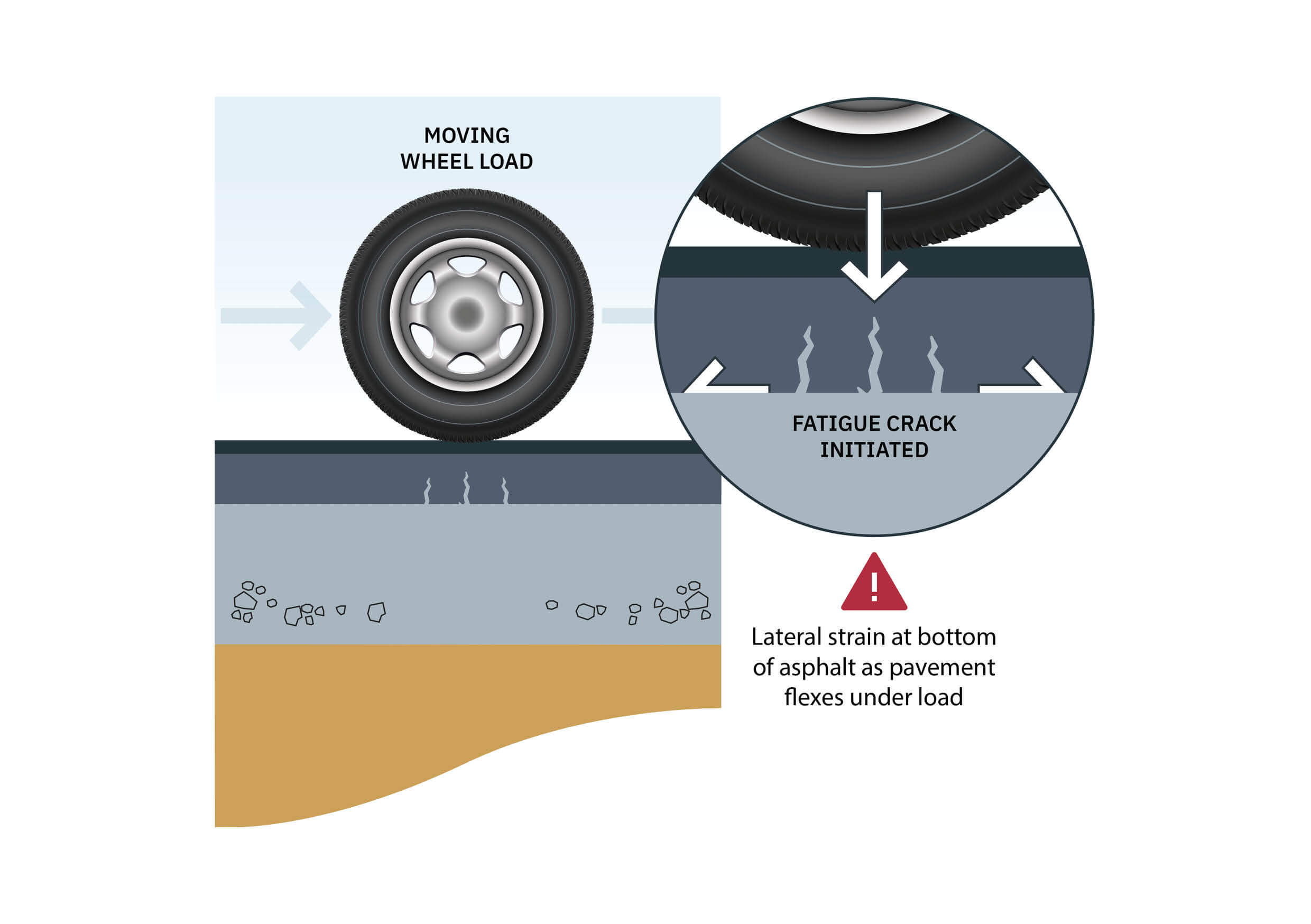
Other factors may also contribute to pavement cracking, including:
● Poor drainage
● Ageing of the asphalt
● Shrinkage cracking (due to thermal movements or the presence of expansive clay subgrade soils).
● Reflective cracking (where a new asphalt layer has been laid over existing cracks, these will eventually reflect through to the surface – this can be minimised using an asphalt reinforcement interlayer such as Tensar AX5-GN,can delay the onset of reflective cracking and any other bottom-up mode of cracking).
● Utility works (in cases where trenches have been excavated in the road and backfilled, settlement can occur leading to surface cracking if the work is carried out poorly).
See our post on types of road cracks and how to avoid them to learn more.
Stage 2 – Water enters the pavement
Water seeps down through the pavement layers, saturating the aggregate subbase and base layers and softening the subgrade soil below.
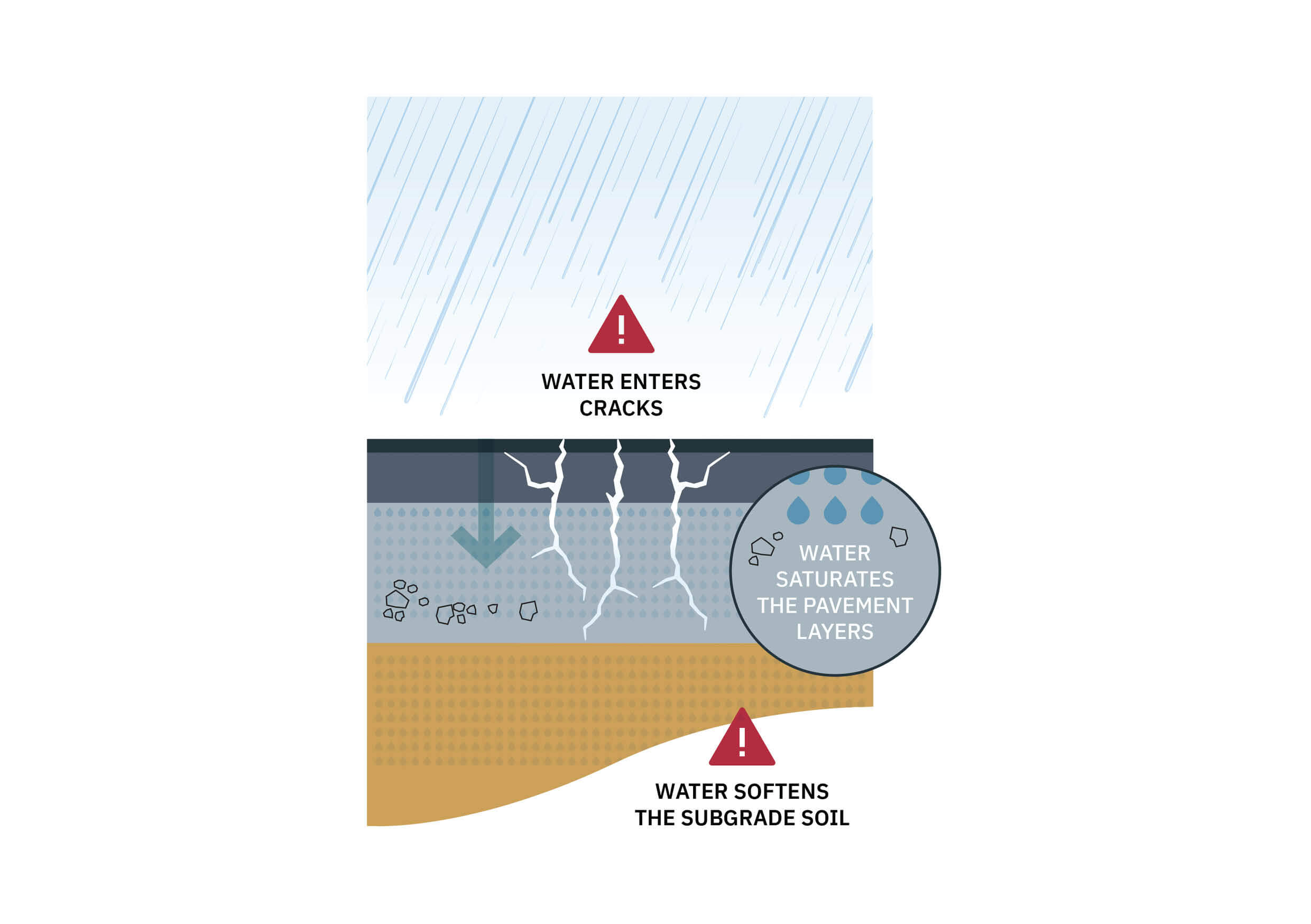
Stage 3 – Traffic pounds the pavement
Traffic loading begins to break up the fractured surface. Small blocks of asphalt are thrown out, initiating a pothole that then expands and deepens. Traffic-induced pumping action of water at the subgrade/subbase interface causes fine soil particles from the subgrade to contaminate the aggregate subbase, resulting in further pavement weakening and further increases in pavement flexing under traffic.
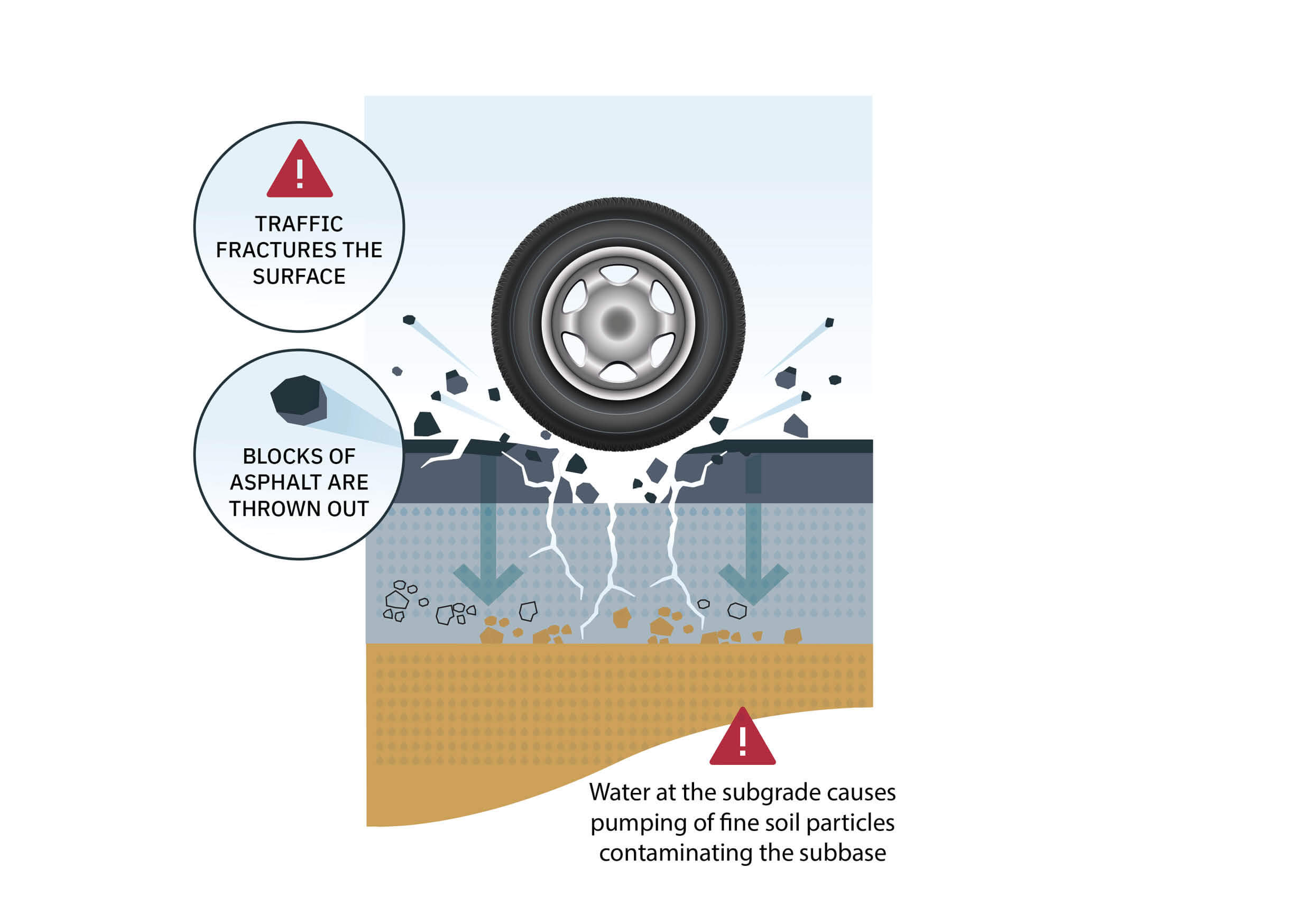
Stage 4 – Freeze-thaw cycles accelerate development
In regions where freezing temperatures occur, water in the pavement freezes and expands opening up cracks and bursting the asphalt around the pothole, accelerating development.
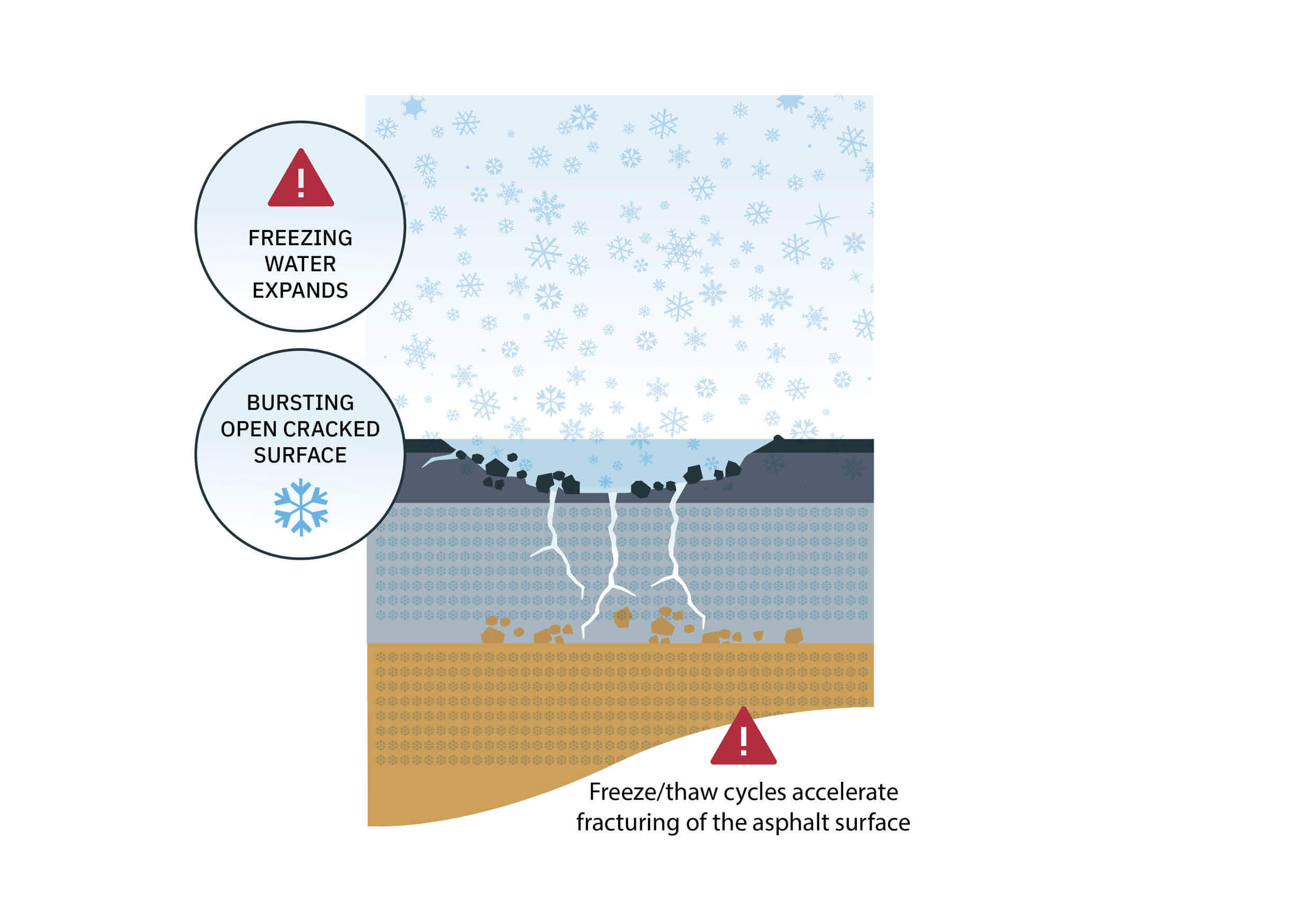
Stage 5 – Standing water completes the process
Water ponding in the potholes after rainfall scours and ejects material under the action of traffic, rapidly expanding and deepening the pothole.
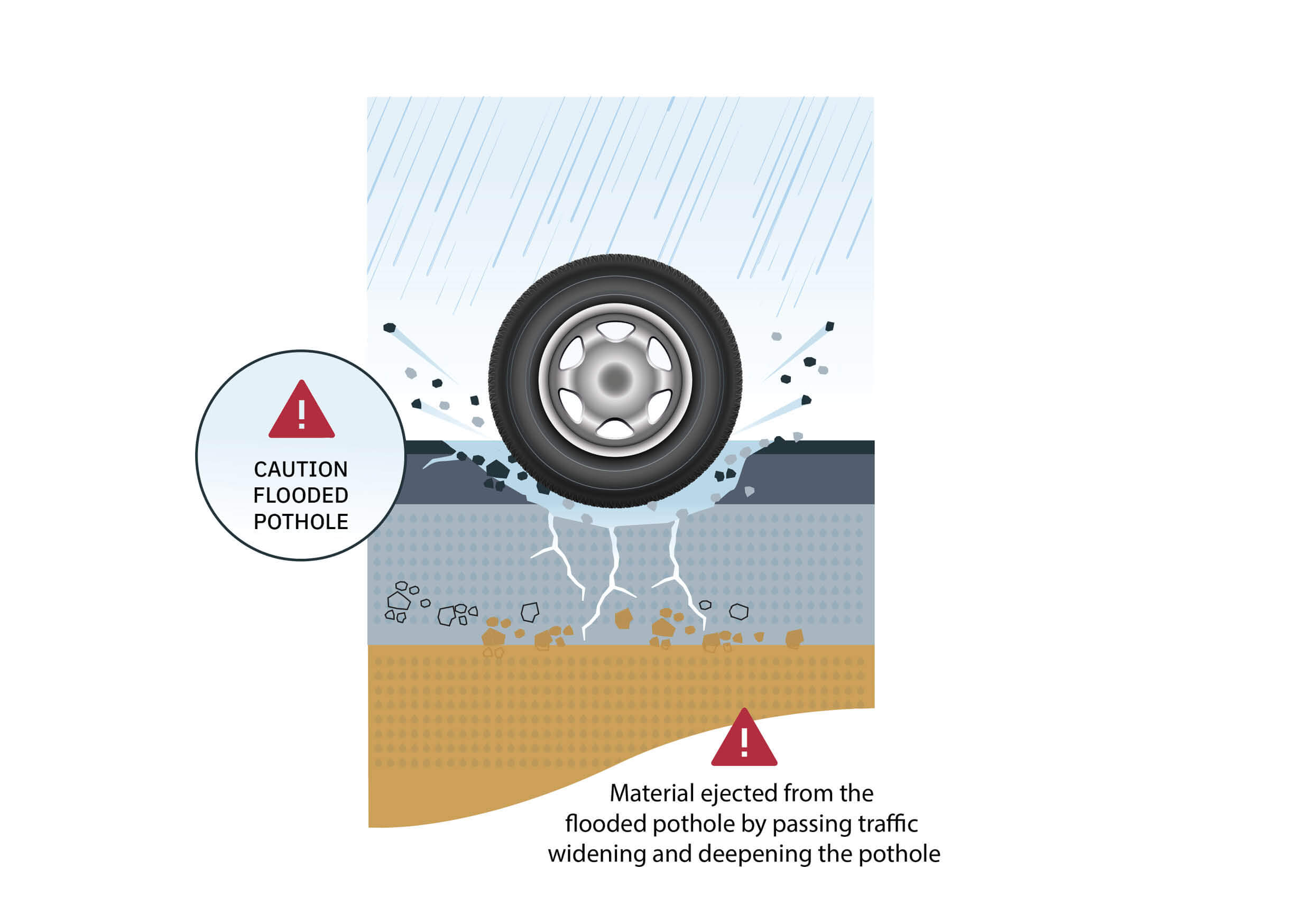
Which part of the road is most vulnerable to potholes?
Potholes require the passage of vehicles to initiate and develop, so they will tend to occur under the wheelpaths. The exception will be where poorly backfilled utility works are the cause.The presence of water in the subgrade is another contributory factor. This is more likely to occur below the outer wheelpath closer to the road edge.
And why do potholes come back in the same places?
Pothole repair is usually a surface- only repair. The pothole is trimmed back and the hole filled with asphalt, compacted and sealed around the edges. This will not have addressed the underlying problem where fatigue cracking due to inadequate pavement thickness or poor drainage is the cause of the pothole. In such cases the pothole can be expected to re-appear, sometimes very quickly.
What factors lead to potholes?
Poor road maintenance is often proposed to be the cause of potholes, and this can be the case. Periodic resurfacing or sealing is needed to prevent ageing of the asphalt that can lead to break-up of the surface. Regular maintenance of side drains is also a requirement if the road foundation is to be protected.
However, in most cases it is the pavement structure that is the root cause of potholes. The construction may have been inadequate from the outset, but it is more likely that increased traffic loading now exceeds the original design or that issues with drainage below the road foundation have locally weakened the pavement. These problems require more than surface road repair and budgets may not stretch to reconstruction.
So, why does the UK have so many potholes?
In the UK, while the average highway maintenance budgets increased by 4% in 2021/22, the proportion allocated to the roadway reduced to 51% representing real terms cut. The backlog of maintenance work is estimated to cost £12.64 billion, and the Asphalt Industry Alliance (AIA) estimate this would take a decade to complete. Potholes are going to be a feature for decades to come.
Poorly reinstated utility excavations are also a major factor leading to pothole development. Over 2 million utility excavations are carried out on UK roads every year, where private utility companies have the legal right to dig up the roads, even recently completely new roads. While utilities companies have an obligation to reinstate the road to a certain standard, this is sometimes not achieved.
Is the UK in a worse position compared to other European countries? Potholes are universally present. However, the UK does have some specific contributory issues apart from budget allocation:
● UK roads carry much higher traffic loads than most other countries.
● The UK also has a very high density of utilities buried under its roads.
● Winter temperatures in the UK tend to be just above freezing for much of the time but with frequent dips below zero. The result is that there are more freeze-thaw cycles in the UK compared to some Northern European countries where temperatures remain below zero for longer periods.
Why do potholes form most often in spring?
Freeze- thaw cycles are a significant accelerator in the formation of potholes. During the winter months, temperatures regularly dip below zero. Each cycle creates more damage to potholes, widening and deepening them. The result is that come spring, our roads are in a significantly worse state.
How to prevent potholes from forming in the first place
While much attention is focussed on the need to repair potholes – a never ending cycle – highway engineers recognise the importance of constructing new roads in such a way as to prevent potholes from forming in the first place. The key to this is to build roads that are not going to develop fatigue cracking. The challenge is how to future proof road construction without inflating costs.
Avoiding fatigue cracking of the asphalt
Fatigue cracking occurs when the road pavement is insufficiently stiff to carry the traffic loading that occurs without excessive flexing. We can increase the strength and stiffness of a pavement by increasing the thickness of one or more pavement layers.
Increasing the asphalt base layer thickness, or the granular subbase layer thickness – or both – will increase stiffness and reduce deformation under traffic load. It is also essential to correctly predict the whole-life traffic loading on the pavement, that is the accumulated number of standard axle passes during the entire design life.
Any increase in layer thickness, asphalt or granular material, will involve greater construction cost, a longer construction period and an increase in total carbon emissions. This is becoming increasingly unacceptable in today’s economically stretched and environmentally conscious world. An alternative approach is to optimise the pavement design by use of a mechanically stabilised layer. And this is where Tensar can provide a solution.
Tensar’s role in preventing pothole formation
To reduce the fatigue-related cracking that leads to pothole development, we need to increase the strength and stiffness of pavements without inflating construction costs. By incorporating Tensar InterAx geogrids into the road foundation layers to stabilise and strengthen the granular material, the strength and stiffness of the pavement is enhanced. In this way, traffic-carrying capacity is increased without the need to increase layer thickness. This has a positive impact on construction cost and carbon emissions.
By increasing the traffic-carrying capacity of new pavements by incorporating Tensar InterAx geogrid, pavement flexing and associated fatigue-related cracking is reduced. In this way, the future development of fatigue-initiated potholes can be avoided.
In turn, when it comes to the maintenance operation, where there is no option to replace the whole pavement structure, the new asphalt overlay can be enhanced with an asphalt interlayer. By incorporating Tensar AX5-GN geocomposite at the bottom of the new asphalt entire package to stabilise and strengthen the bound asphalt course, the fatigue cracking prevention and fatigue life of a pavement is provided.
What next?
We have seen how most potholes are initiated by cracking of the road surface under the action of traffic. This fatigue-related cracking occurs when the pavement construction is insufficient for the true volume and loading from traffic using the road. Once potholes initiate, they rapidly expand under the action of traffic whenever water is present. This is further accelerated by freezing and thawing of water seeping into the pavement layers.
While significant sums will still need to be spent repairing potholes well into the future, the development of potholes in new road construction can be eliminated by optimising the pavement design using mechanically stabilised road foundations and pavement layers that incorporate a stabilising geogrid such as Tensar InterAx.For existing pavements, the recurrence of potholes in asphalt overlays can be delayed by the incorporation of a reinforcing asphalt interlayer such as Tensar AX5-GN.
To find out more, visit our geogrids for road, pavements and trafficked areas page. If you’d like to submit a project or an enquiry, head to our support page.
Found this post useful? You might also want to take a look at:
● Types of road cracks and how to avoid them
● What is rutting in roads?
● Designing road foundations to DMRB-CD225
You can also download our full white paper on the causes of potholes here.


